Sample Terms and Conditions Template
Terms and Conditions agreements serve as a legally binding contract between you (the business) who manages a mobile application or a website and the customer who uses your app or visits your website.
They are otherwise called Terms of Use or Terms of Service agreements and are shortened as T&Cs (or ToU and ToS, respectively).
No two businesses are identical, and as such, every business needs a unique T&C agreement designed to meet its specific needs. While some clauses are conventional and usually seen in basically every Terms and Conditions agreement, you ultimately decide what regulations and guidelines your customers must accept.
Let's take a look at what clauses should go into most Terms and Conditions agreements, as well as how to display and get legal agreement to your T&C.
Although employing a Terms and Conditions agreement is fully optional as there are no laws that necessitate it, this agreement is highly recommended by experts and presents lots of benefits for both your company and customers.
What are the Advantages of Having a Terms and Conditions Agreemt?
Some of the advantages to be derived include the following:
Clarity
Terms and Conditions agreements provide clarity about what should occur in any given circumstance. They set out the essential business terms you are offering to your customers and help contractual parties to understand their rights, obligations, functions, and accountabilities.
A Comprehensive system
Your Terms and Conditions agreement produces a well-organized and comprehensive system by covering commercial terms such as delivery, price, payment, and other areas often overlooked by businesses.
They also proceed to limit your liability, disclaiming your liability for failure or delay caused by inevitable circumstances, therefore protecting your intellectual property rights.
Conformity with Laws
There may be specific regulations that apply to your industry, and you may refer to them in your Terms and Conditions. Having a defined Terms and Conditions agreement helps ensure conformity with applicable laws.
Confidence and Consistency
Having a clear set of Terms and Conditions helps you deliver a consistently excellent level of customer service while avoiding any ambiguity.
By doing this, customer's expectations are well-managed regarding delivery and payment, therefore eliminating disappointments in your provision of services.
Assurance
If you have a clear set of Terms and Conditions, it is considerably easier to spot a breach of contract. Written contracts provide assurance and are easier to enforce whenever required.
Having a comprehensive set of Terms and Conditions also helps minimize the probability of getting a legal dispute. It is more prudent to have a Terms and Conditions agreement prepared than be involved in prolonged and expensive litigation.
What are Some Clauses I Should Add to my Terms and Conditions Agreement?
Terms and Conditions are considerably broad in the abstract sense. However, as businesses differ, they require some specific clauses that are exclusive only to their form of business, depending on:
- The size of the contract
- The complexity of the agreement
- The industry
Generally, almost every Terms and Conditions agreement should include the subsequent clauses:
An Intellectual Property clause
This clause is a provision where you, the business owner or inventor, retains ownership of your patents, copyrights, trademarks, trade dresses, or trade secrets.
Intellectual property security is crucial to promoting innovation.
Without the protection of ideas, individuals and businesses would not gain the full benefits of their creativity and would concentrate less on research and development.
Here's an example of Amazon's Intellectual Property Policy for sellers on its platform:

This excerpt from Amazon sets out what sellers must do, and what they must not do when it comes to IP rights. It also adds some definitions and extra information for clarity, which is helpful to the readers.
A Disclaimer and Limitation of Liability clause
This type of clause is a contractual stipulation or disclaimer for an agreement that defines the circumstances under which you (the disclaiming party) could be held responsible for damages or loss.
It further sets the boundaries of damages that may be claimed in certain situations. This clause limits the amount payable as well as the exposure a company faces if a lawsuit is filed or another claim is made.
If deemed admissible, a Disclaimer and Limitation of Liability clause can "cover" the number of possible losses to which a business is exposed.
For example, a mobile app user experiences loss because they relied on information provided on that app. A Disclaimer and Limitation of Liability clause in the app's Terms and Conditions agreement could restrict the liability of the app owner, and by extension, limit the recoverable amount of the user.
Here's an example of The Coca Cola Company's Disclaimer and Limitation of Liability clause:
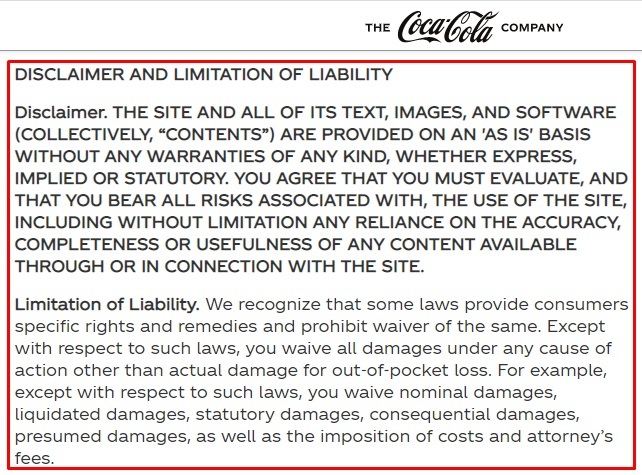
Here's an additional example of a Disclaimer and Limitation of Liability clause embedded in the Netflix Terms and Conditions:
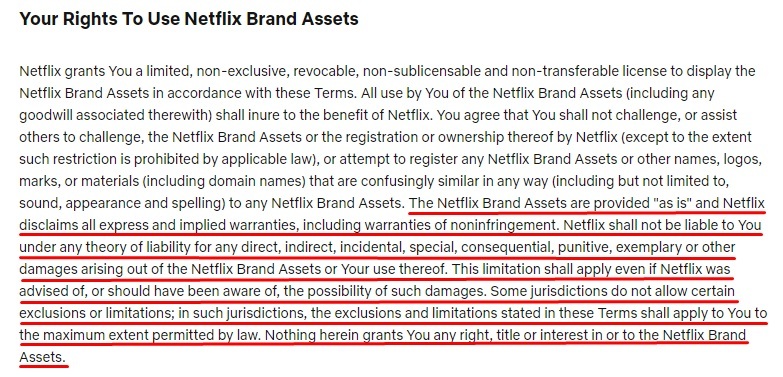
A Termination of Agreement clause
This clause provides specifications of the conditions under which individuals in a contract may dissolve their legal relationship and abandon the fulfillment of their duties. This covers the implication of termination, such as payments and other privileges and responsibilities of the contracting parties.
According to common law, you and your client may terminate an agreement for a material or a basic breach of the agreement.
A standard agreement may also be terminated for the following reasons:
- Mutual agreement
- The bankruptcy of a party
- A legal mandate that forbids the agreement
- Following its Terms and Conditions (i.e., the expiration of the term of the agreement, or if defined activities are conducted)
Termination of agreement clauses are highly recommended and essential in various contexts because they oversee both you and your client's rights and responsibilities if the business transaction becomes unsustainable. Ordinarily, meetings and negotiations precede termination, and therefore termination is, for the most part, the last resort.
In its Terms and Conditions agreement, Starbucks provides details of its Termination clause which includes a 15-day written notice, and conditions under which termination may occur:
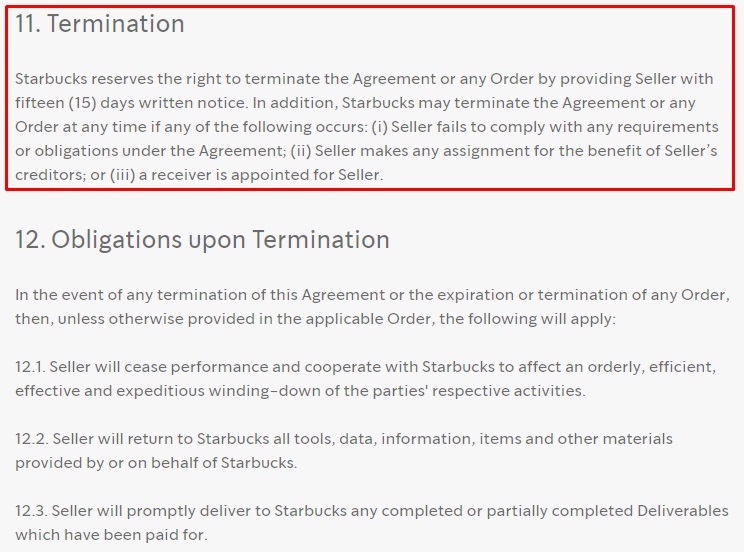
It further outlines the obligations of the seller once the termination takes effect.
A Governing Law clause
This clause is a stipulation usually employed in legal contracts, as it determines which regulations and laws will take effect in the case of a legal controversy.
A business contract sets the terms under which the contracting individuals will do business. The implication and impact of these terms can, however, differ significantly, subject to which country's legislation governs them.
A governing law clause, therefore, tries to express your choice for the applicable law. This clause is usually included in standard Terms and Conditions agreements for mobile apps or websites.
As an example, Target prefers the use of arbitration to resolve disputes:

Its governing law and arbitration rules are further detailed below:

User Rights, Responsibilities, and Guidelines
This is an essential clause in any reliable Terms and Conditions agreement as it describes the rights and responsibilities of users as well as guidelines for using the service in a direct and concise manner.
This clause lists rights to be enjoyed by your users as well as responsibilities and firmly states what is not acceptable in their use of your service.
This can be a part of an extended and thorough list in your Terms and Conditions agreement to cover the most volume of negative practices.
Here, we can see the Rights and Responsibilities of users in Spotify's Terms and Conditions of Use:
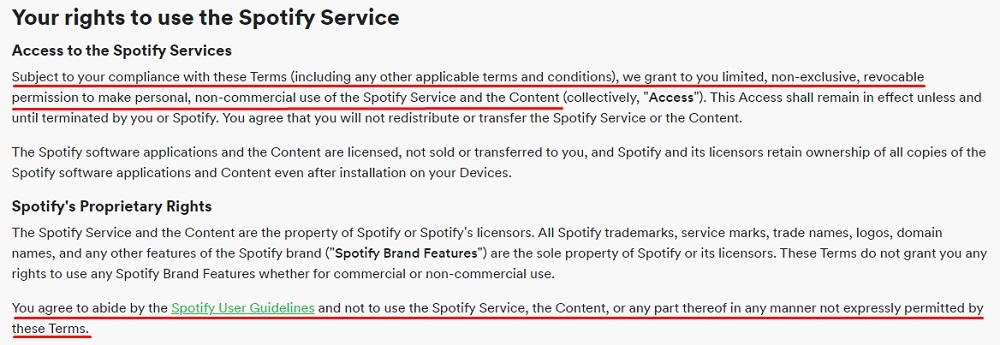
Spotify also briefly references its User Guidelines three sub-headings below:

A Payments and Prices clause
This clause is a requisite part of any Terms and Conditions agreement designed for websites, mobile apps, or similar platforms that involve subscriptions or paid services.
Without this clause in place, issues or misunderstandings regarding payments and prices are inevitable. A well-drafted Payments and Prices clause informs users explicitly about vital information such as:
- The acceptable currency or currencies
- The satisfactory method of payment
- The results of not meeting payment obligations
- Potential adjustments in future prices
Here's an example of the payment processing company Square describing its payment terms:
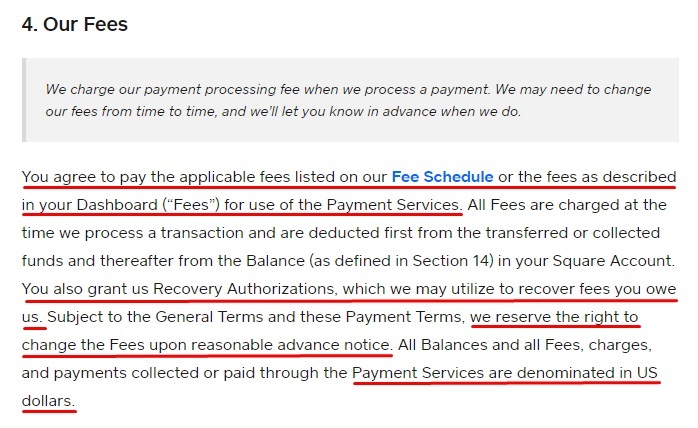
HelloFresh also provides a Payments and Prices clause in its Terms and Conditions:

User Submissions/User Generated Content clause
Operating a mobile app or website that allows user-generated content necessitates a User Submissions clause in your Terms and Conditions agreement. These clauses are also known as a User Generated Content clause.
A well-drafted User Submissions clause should emphasize that your business doesn't create user-generated content, and all uploaded content belongs to the users uploading them or has been approved for use by the original owners.
A reliable User Submissions clause should also distinguish acceptable from non-acceptable user-generated content. For example, you may explain that content uploaded by users must not contain offensive or demeaning language.
Wattpad, for example, shows its User Submissions clause in a simplified way as shown below:
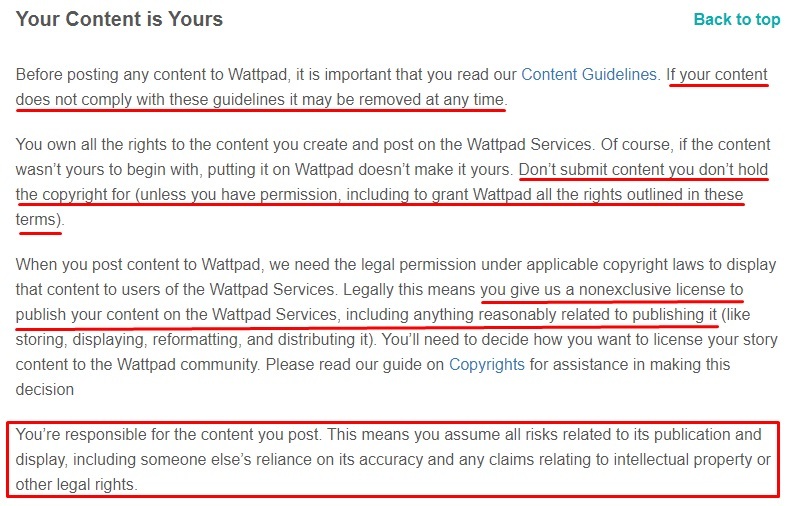
YouTube also has a similar User Submissions clause in its Terms of Service agreement:
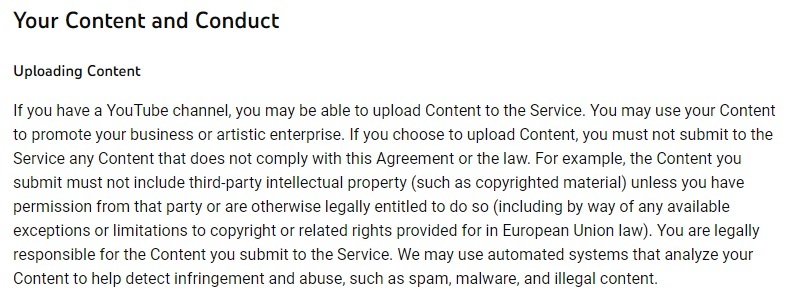
Now that you have an idea of what clauses to include in your Terms and Conditions agreement, let's look at where you display your agreement for maximum effectiveness and availability.
Where Should I Display my Terms and Conditions Agreement?
A standard Terms and Conditions agreement should be readily available to users and be systematically placed at pivotal points where they are most likely required.
As such, Terms and Conditions should be found anywhere a relationship is established between you and your client or end-user.
This serves to remind users about your Terms and Conditions at crucial points in their exploration where they may need to reference them.
Generally, most Terms and Conditions are found in the following places:
Account Sign-up or Registration Forms
One of the most common places to reference your Terms and Conditions agreement is the account sign-up or registration form webpage of your business.
They are logically placed here to introduce new explorers to your Terms and Conditions before they become users of your service.
Here's how TikTok references its Terms of Service agreement for users signing up on its platform:
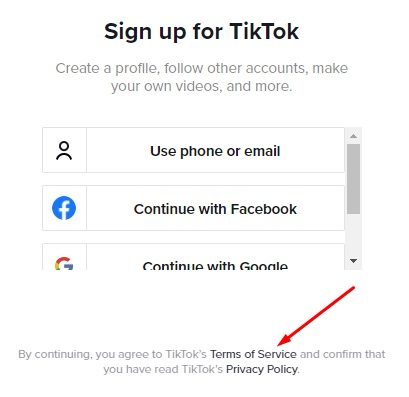
Website Footers
Another common practice adopted by many businesses is the placement of their Terms and Conditions agreement in the footer of their website.
Like many others, Uber places its Terms agreement in its website footer:

Mobile or Desktop In-app Menus
Terms and Conditions agreements are also linked in mobile or desktop app menus. In its mobile app menu, Grammarly links its Terms of Service agreement as shown below:
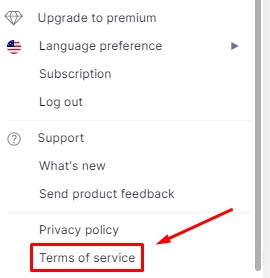
Email Newsletter Sign-up Forms
A link to your Terms and Conditions agreement may be provided when offering email newsletter sign-ups for your users.
Here's an example of Bloomberg linking its Terms of Service agreement on its email newsletter sign-up form:
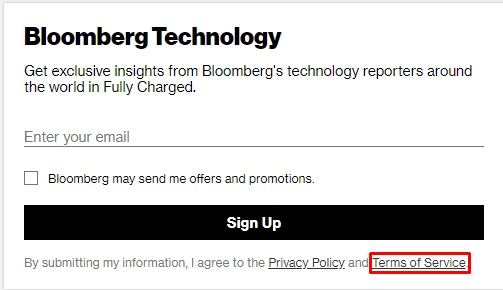
Now that you know how to draft and display your Terms and Conditions agreement, how can you get users to agree to it?
How Do I Make my Terms and Conditions Agreement Enforceable?
Preparing a comprehensive Terms and Conditions agreement does not automatically make it enforceable in legal affairs.
Your users must consent to the terms provided in your agreement to make your Terms and Conditions an enforceable contract. As such, you should always obtain explicit, unexceptionable consent to your agreement.
The best way you can accomplish this is by ensuring your users tick an unchecked box or click a button to confirm their consent to your Terms and Conditions.
For example, Vudu provides a box for new users to tick, confirming their consent to the Terms and Policies of the business:
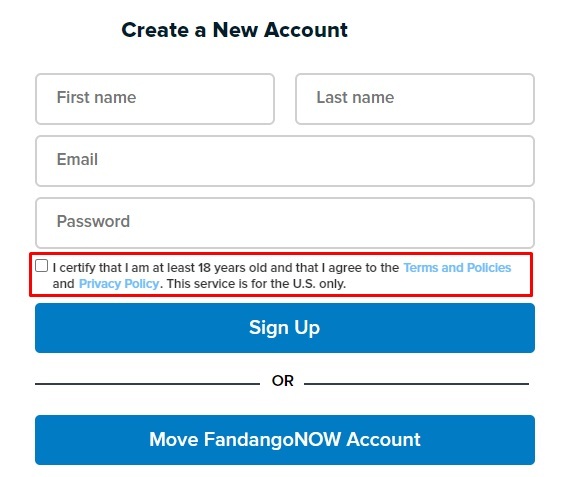
Tumblr also ensures that its Terms of Service are enforceable by seeking user consent as shown below:
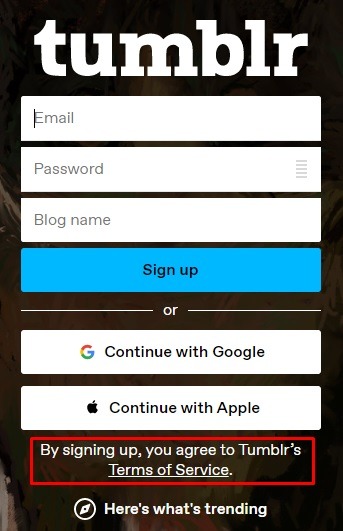
Summary
A reliable Terms and Conditions agreement lets your users know what they can expect from your business and what is expected from them.
It formulates a contract between your business and the end-user as well as helps protect your business from potential legal problems.
Important points to note in the preparing a Terms and Conditions agreement are as follows:
- A complete and well-detailed Terms and Conditions agreement minimizes the risks of getting legal disputes.
- The consent of users ensures your Terms and Conditions agreement is enforceable.
- Using simple, plain language in your Terms and Conditions agreement comes with benefits.
- Your Terms and Conditions agreement should be easy to locate and displayed in various areas of your website or app.
- Having a solid Terms and Conditions agreement with appropriate consent allows you to enforce your regulation and guidelines whenever required.